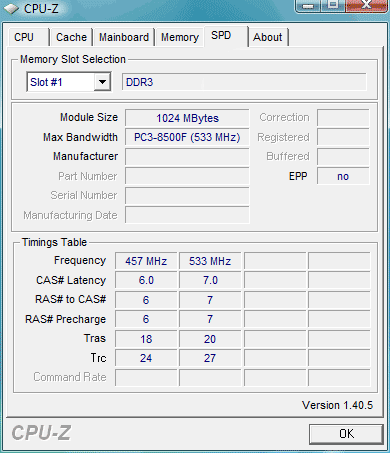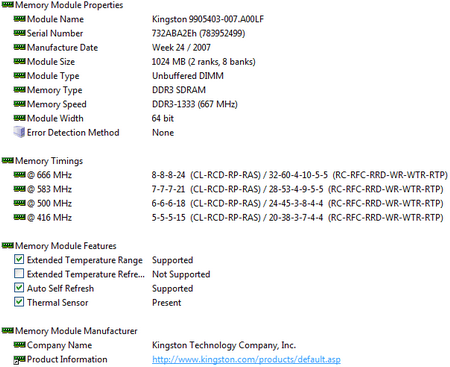DDR2 VS DDR3 1600 MHZ PERFORMANCE REVIEW BENCHMARK AND OVERCLOCKING
![]()
|
|
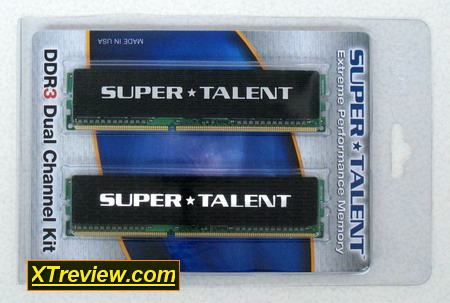 |
||||||||||||||||||||||||||||||||||||||||||||||||||||||
| Posted:2007-08-21 By memory review Number of View:98298 |
|||||||||||||||||||||||||||||||||||||||||||||||||||||||
By :memory review Posted:2007-08-21
Previous DDR3 test showed that in this stage the new memory cannot ensure a visible performance advantage in comparison with high-frequency DDR2 SDRAM. The relatively high latency in DDR3 modules , which functions at 1333 MHz frequency , loses in speed vs the widely accessible DDR 2-1066 with latency 4- 4- 4-12 in a large number of applications with different nature. The highest-speed DDR3 SDRAM , officially supported by Intel chipset at the given moment, has the frequency 1333 MHz and latency 7-7-7 . But many memory producers (memory overclocker) already supply DDR 3 with 1600 MHz and even prepare the sales of DDR 3-1800. High frequencies became possible due to the efforts of micron company , which began the production of Z9 chips , the continuing traditions for overclocking DDR2 microcircuits (micron D9), which after making some selection and increasing the supply voltage are capable to work at frequencies, which considerably exceed regular. But here we have some problems , the memory module with this frequency cannot be used in a systems, based in Intel p35 with any default system bus processor frequency ( 800/1066/1333 MHz ). This chipset does not simply have the necessary dividers for such high frequency memory Therefore, DDR 3-1600 SDRAM present interest exclusively for overclockers, which overclock their processors with FSB frequency increase . . Configuration AND memory characteristics :To check the characteristics of the tested module and also their overclocking possibilities, we used the following system which includes :
Memory overclock was with 1:1 and 5:6 FSB:Mem dividers . The system stability was checked by memtest86, S&M and SP2004/ORTHOS. Super talent W1600UX2G7 review :Since super talent became the first memory overclocker producer , that began to operate with micron chips for the release of high-speed DDR3 SDRAM, we used the memory module DDR 3-1600 Mhz from its product. The complete set super talent W1600UX2G7 consists in two modules DDR 3-1600 (PC 3-12800) with volume 1 Gb each. Collection is supplied in the standard plastic cover.  Modules appear somewhat unusually, chips are located only from one side. However, this is not surprising, since they are based on microcircuits with 1 Gbit capacity . Accordingly, the black aluminum radiator, which ensures the heat removal from the chips, is placed on the modules only from one side, on the other one it is possible to see the naked PCB surface with the marking. It is also possible to see the information about the product type , the modules volume , regular frequency, latency and chips producer . 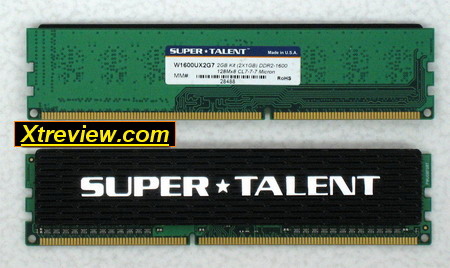 Super talent guarantees a stable work for the complete set W1600UX2G7 at 1600 MHz frequency with latency 7-7-7-18 and vmem voltage 1.8 v. in other words, for achieving the declared frequency the producer proposes to use a voltage, which exceeds regular by 20%. The complete product specification appear as follows:
The producer assert that those modules was tested on the motherboard ASUS P5K3 deluxe. Here is the SPD value :
Super talent W1600UX2G7 Overclocking :The real possibilities of super talent W1600UX2G7 memory module are somewhat better than the declared in the specification. With the latency 7-7-7-18 those modules proved to be stable at the frequency 1632 MHz, and with higher latency 9 9 9-24 ,the frequencies rose only to 1652 MHz. With the default frequency 1600 MHz , the modules can stably function not only with the latency 7 -7- 7-18, but also with the improved to 7-6- 6-18 . A increase in the voltage supply affects super talent W1600UX2G7 overclock strongly. With the voltage 2.1 v the maximum frequency (stable) with latency 9 9 9-24, was 1760 MHz, while with the latency 7-7-7-18 the max frequency was only 1672 MHz. The obtained results cause some disappointment. The first memory copy super talent W1600UX2G7 could be overclocked to 2 GHz. Maybe be this was an unlucky memory module ..... OCZ PC 3-12800 Platinum dual channel enhanced bandwidth edition review :This complete set, which consists on a pair of giga-byte modules is designed for work with frequency 1600 MHz with more aggressive than Super talent W1600UX2G7 latencies 7-6-6-20. But here the default voltage in modules from OCZ is higher (1.9 v vs 1.8v). The Delivery of OCZ PC 3-12800 Platinum dual channel EB edition is standard : the complete set is placed in the standard plastic cover. 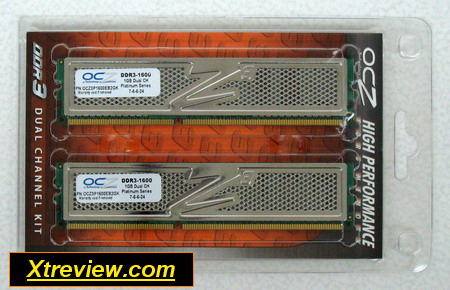 OCZ company did not economize on radiators and supplied them on each module from both sides. The memory cooler is made from copper , using the technology XTC (Xtreme thermal convection), which has a good effectiveness. On the memory its possible to reveal : its frequency, volume for each module and regular latencies . Here is the complete characteristics of this memory :
Let us note that OCZ separately promises the safety of modules use , with high voltage ( 1.95 v), which exceeds default voltage by 30%. OCZ also separately note the optimization of its DDR 3-1600 SDRAM module for ASUS motherboard . 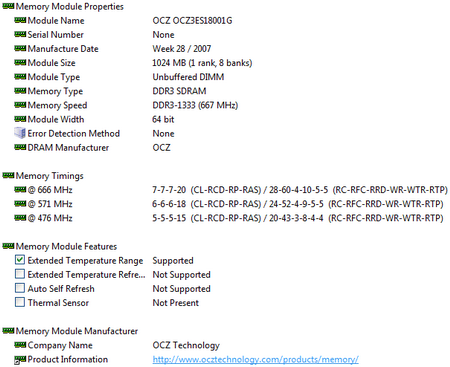 The Contained in SPD value for the memory OCZ PC 3-12800 Platinum dual channel EB edition is standard, here all is oriented to the compatibility in any motherboard without increase in the supply voltage. OCZ PC 3-12800 Platinum dual channel enhanced bandwidth edition overclocking :We obtained the following results with default voltage overclocking . Frequencies on the diagram above are obtained with the voltage 1.9 v. I, it is necessary to note that , OCZ PC 3-12800 Platinum dual channel EB edition shows the best results, better than Super talent W1600UX2G7 with any latencies. With the latency 7-7- 7-18 OCZ module demonstrates its capability for stable functioning at frequencies up to 1704 MHz, and larger latency 8-8- 8-21 allow to reach 1808 MHz. However, with the default frequency 1600 MHz, as showed tests, OCZ PC 3-12800 Platinum dual channel EB edition can work not only with the latency 7-6- 6-20, but also with more aggressive latency 7-6-5-18. A increase in voltage improves OCZ PC 3-12800 Platinum dual channel EB edition overclocking result ( this is the characteristic property of micron chips ) . Thus, with the supply voltage 2.1 v , the memory was stable at 1752 MHz with latency 7-7-7-18. As overall, OCZ PC 3-12800 Platinum dual channel EB edition show higher results, than Super talent W1600UX2G7. However, this is also clear from the memory cost. The price difference between these complete with similar characteristics reaches 15%, This taking in account the sufficiently high prices of DDR3 SDRAM..... Kingston KHX11000D3ULK2/2G review :The only Kingston modules available for us was KHX11000D3ULK2/2G , its oriented to work only with 1375 MHz frequency .  This DDR3 modules has the default frequency 1375 MHz and latency 5-7-5-15. In this case the default voltage is established to 1.75 v. As a difference in the characteristics Of Kingston KHX11000D3ULK2/2G appears elpida company . In contrast to the gigabit micron microcircuits , these chips have 512 Mbit capacity . Accordingly, the aluminum heat-distributor on the memory from Kingston are installed from both modules sides .  The radiators contain information about the general memory type and the regular voltage. More detailed information is located on the packing : there its possible to check all data about the total product volume, its regular frequency and latency. The complete characteristics Of Kingston KHX11000D3ULK2/2G appears as follows:
Important note for Kingston KHX11000D3ULK2/2G memory module is its applicability with the default processors system bus frequency ( 1333 MHz ) to work in regime 1:1. In addition Among the presented DDR 3-1333 memory modules the complete set Kingston KHX11000D3ULK2/2G proposes the best latency combination . The Contained SPD value in Kingston KHX11000D3ULK2/2G are standard :
Kingston KHX11000D3ULK2/2G overclocking :The Practical study of Kingston memory overclocking possibilities give a completely curious picture. On the following graph are given the maximum frequencies, where Kingston KHX11000D3ULK2/2G preserves capability for stable functioning with its regular voltage 1.75 v. The latency test of the modules Kingston KHX11000D3ULK2/2G show the worst results ( than products on base of micron chips ) , they actually work with 1375 MHz frequency using the latency 5-57-5-15 regime, inaccessible neither for OCZ PC 3-12800 Platinum dual channel EB edition north for Super talent W1600UX2G7. Kingston memory modules (elpida chips) react weakly to increase in the supply voltage : with 2.1 v , the maximum frequency was only 1486 MHz. Thus, Kingston KHX11000D3ULK2/2G is interesting only by its low latencies with frequencies, close to 1333 MHz. DDR3 Module overclocking summaryDDR3 1600 MHz system performance :To test the DDR3 latency and frequency impact we used the following system :
DDR 3-1600 against DDR2 Performance :Memory system synthetic testsAs start we used the utility Everest ultimate edition 4.00. 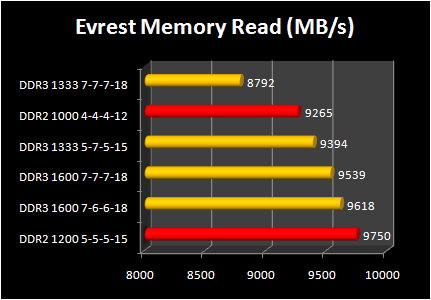 The maximum memory capacity demonstrates DDR 2-1200. Even DDR 3-1600, whose theoretical speed is higher was not capable to win over previous generation memory. Obviously, the fault is due to the high latency in DDR3 SDRAM. However, DDR 2-1000 with the most aggressive latencies 4- 4- 4-12 during memory reading shows lower speed , than DDR 3-1600, and than DDR 3-1333 with latency 5-7-5-15. 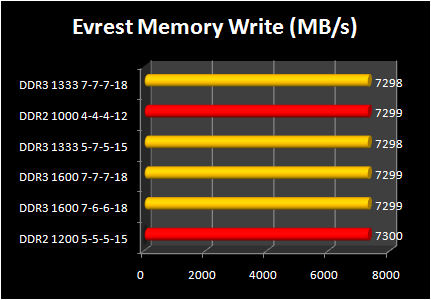 Memory writing speed is limited by the practical processor system bus capacity ; 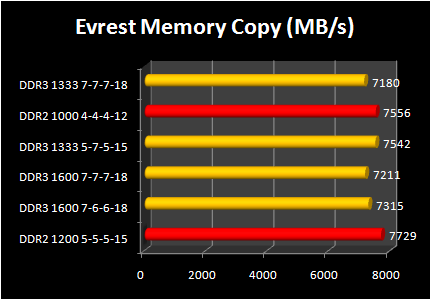 During data copying , the memory latency plays a big role. Therefore the highest result in this test was from DDR 2-1200 with latency 5-5*5-15, and in the second place was for DDR 3-1333 with the latency 5-5-15 and DDR 2-1000 with latency 4- 4- 4-12. However, the memory modules DDR3 with CAS latency equal 7 in this test demonstrate the much worse result. 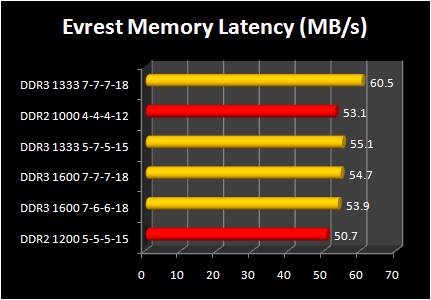 In other words, today\'s comparison DDR2 and DDR3 SDRAM , is again converted in test : capacity against latency. Let us pass to complex benchmarks to tests the real applications performance impact. SuperPi, PCMark05, 3DMark06 The highest result in superPi test shows DDR 2-1200 SDRAM. However, the second place is finally occupied by DDR 3-1600 with latency 7-6-6-18. Approximately the same figure in PCMark05. DDR 2-1000, in spite of its relatively low frequency show a very good speed .
3DMark06 depends on memory system parameters weakly. So there is no real deference between all used memory 3d- game DDR2 vs DDR3 Performance :
In all utilized by us games , the DDR 3-1600 SDRAM with latency 7-6-6-18 (this is the normal mode for OCZ PC 3-12800 Platinum dual channel EB edition) allow to obtain a slightly higher fps level , than with DDR 2-1200. However, all other DDR3 SDRAM from different versions lose in those test over the DDR2 . Let us note also that DDR 3-1333 with latency 5-7-5-15, cannot compose competition to DDR 3-1600 SDRAM. This tendency is seen in all tests, including game. In other words, for overclocker micron chips memory proves to be undoubtedly more useful, than memory with elpida chips . video Coding DDR2 vs DDR3 Performance :
Finally with coding , the DDR 3-1600 with the most aggressive latencies is capable to support the new technologies. However, the discussion deal here with a small improvement , in addition DDR2 memory still in the second position with a resectable result. Office applications DDR2 vs DDR3 Performance :
During archive application the first performance places are occupied by DDR2 memory, but with Excel calculation the situation is exactly the reverse. Final rendering DDR2 vs DDR3 Performance :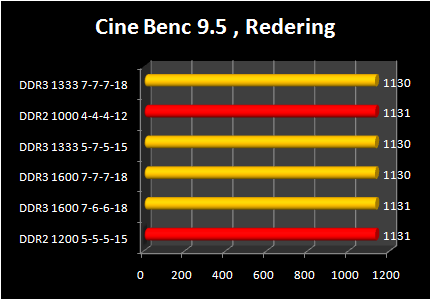 Final rendering tasks do not depends on the memory speed .... ConclusionsAccording to the obtained tests results , neither DDR 3-1333 with the extremely low latency north DDR 3-1600 could ensure unambiguously better speed, than DDR2 memory. Although in some tasks, for example in games, during video coding and in Excel new DDR3 SDRAM shows higher performance, but there is a large quantity of tasks, where the picture is reverse. In other words, DDR3 SDRAM producers move in the correct direction. It is better to move with the new memory , than to overclock the past generation. Since the new technology will include the lower energy consumption , increased volume and with time the higher performance. 1600 MHz is not the limit from micron chip and soon we will introduce analogous DDR 3-1800 MHZ .
we would be happy to answer for your question . if you have suggestion or comment
regarding this review our support would be glad to help just join our forum and ask u will get the best answer
to discuss check our forum section :-) RATE THIS REVIEW | |||||||||||||||||||||||||||||||||||||||||||||||||||||||
![]()

DDR2 vs DDR3 1600 mhz Performance review benchmark and overclocking
DDR2 vs DDR3 1600 mhz Performance review benchmark and overclocking


7600gt review
7600gt is the middle card range.
We already benchmarked this video card and found that ...

 geforce 8800gtx and 8800gts
geforce 8800gtx and 8800gts  Xtreview software download Section
Xtreview software download Section  AMD TURION 64 X2 REVIEW
AMD TURION 64 X2 REVIEW  INTEL PENTIUM D 920 , INTEL PENTIUM D 930
INTEL PENTIUM D 920 , INTEL PENTIUM D 930  6800XT REVIEW
6800XT REVIEW  computer hardware REVIEW
computer hardware REVIEW  INTEL CONROE CORE DUO 2 REVIEW VS AMD AM2
INTEL CONROE CORE DUO 2 REVIEW VS AMD AM2  INTEL PENTIUM D 805 INTEL D805
INTEL PENTIUM D 805 INTEL D805  Free desktop wallpaper
Free desktop wallpaper  online fighting game
online fighting game  Xtreview price comparison center
Xtreview price comparison center 

- The new version of GPU-Z finally kills the belief in the miracle of Vega transformation
- The motherboard manufacturer confirms the characteristics of the processors Coffee Lake
- We are looking for copper coolers on NVIDIA Volta computing accelerators
- Unofficially about Intels plans to release 300-series chipset
- The Japanese representation of AMD offered monetary compensation to the first buyers of Ryzen Threadripper
- This year will not be released more than 45 million motherboards
- TSMC denies the presentation of charges from the antimonopoly authorities
- Radeon RX Vega 64 at frequencies 1802-1000 MHz updated the record GPUPI 1B
- AMD itself would like to believe that mobile processors Ryzen have already been released
- AMD Vega 20 will find application in accelerating computations
- Pre-orders for new iPhone start next week
- Radeon RX Vega 57, 58 and 59: the wonders of transformation
- ASML starts commercial delivery of EUV-scanners
- The older Skylake processors with a free multiplier are removed from production
- Meizu will release Android-smartphone based on Helio P40
- AMD Bristol Ridge processors are also available in American retail
- The fate of Toshiba Memory can be solved to the next environment
- duo GeForce GTX 1080 Ti in GPUPI 1B at frequencies of 2480-10320 MHz
- New Kentsfield overclocking record up to 5204 MHz
- Lenovo released Android-smartphone K8



computer news computer parts review Old Forum Downloads New Forum Login Join Articles terms Hardware blog Sitemap Get Freebies

